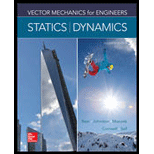
(a)
Find the altitude at which stage A of the rocket is released.
(a)
Answer to Problem 14.102P
The altitude at which stage A of the rocket is released is
Explanation of Solution
Given information:
Consider the initial mass of the rocket is denoted by
The rate of consumption of the fuel is denoted by q.
The velocity of the rocket after time t is denoted by v.
The acceleration due to gravity is denoted by g.
Refer Problem 14.96.
The mass of the rocket is
The mass of the stage A and B is
Show the unit conversion of the mass as follows:
The rate of fuel consumption is
The relative velocity of the rocket is
Calculation:
Show the thrust force (P) of the rocket as follows:
Show the combined mass (m) of the rocket and the unspent fuel as follows:
Show the weight force (W) as follows:
Show the acceleration (a) of the rocket as follows:
Modify Equation (3) using (2) and (1).
Show the velocity of the rocket as follows:
Integrate above Equation with respect to time.
Show the displacement of the rocket as follows:
Integrate above Equation with respect to time.
Consider the value of z as follows:
Differentiate the above Equation with respect to time t.
Consider the value of the
Substitute
Modify Equation (4) using Equation (5) and (6).
Take the lower and upper limit of the integral as
Substitute 1 for
The mass of the fuel is
The velocity of the rocket is
The rate of the fuel consumption is
Calculate the time taken (t) as follows:
Consider the first stage:
The initial velocity and initial distance covered are
Calculate the initial mass of the rocket
Calculate the final velocity of the rocket using the relation:
Substitute 0 for
Calculate the altitude
Substitute 0 for
Thus, the altitude
(b)
Find the altitude at which the fuel of both stages are consumed.
(b)
Answer to Problem 14.102P
The altitude at which the fuel of both stages are consumed is
Explanation of Solution
Given information:
Calculation:
Consider the fuel of both the stages are consumed.
Calculate the final mass
Calculate the altitude
Substitute
Thus, the altitude
Want to see more full solutions like this?
Chapter 14 Solutions
Vector Mechanics for Engineers: Statics and Dynamics
- (read image) (answer given)arrow_forwardA cylinder and a disk are used as pulleys, as shown in the figure. Using the data given in the figure, if a body of mass m = 3 kg is released from rest after falling a height h 1.5 m, find: a) The velocity of the body. b) The angular velocity of the disk. c) The number of revolutions the cylinder has made. T₁ F Rd = 0.2 m md = 2 kg T T₂1 Rc = 0.4 m mc = 5 kg ☐ m = 3 kgarrow_forward(read image) (answer given)arrow_forward
- 11-5. Compute all the dimensional changes for the steel bar when subjected to the loads shown. The proportional limit of the steel is 230 MPa. 265 kN 100 mm 600 kN 25 mm thickness X Z 600 kN 450 mm E=207×103 MPa; μ= 0.25 265 kNarrow_forwardT₁ F Rd = 0.2 m md = 2 kg T₂ Tz1 Rc = 0.4 m mc = 5 kg m = 3 kgarrow_forward2. Find a basis of solutions by the Frobenius method. Try to identify the series as expansions of known functions. (x + 2)²y" + (x + 2)y' - y = 0 ; Hint: Let: z = x+2arrow_forward
- 1. Find a power series solution in powers of x. y" - y' + x²y = 0arrow_forward3. Find a basis of solutions by the Frobenius method. Try to identify the series as expansions of known functions. 8x2y" +10xy' + (x 1)y = 0 -arrow_forwardHello I was going over the solution for this probem and I'm a bit confused on the last part. Can you please explain to me 1^4 was used for the Co of the tubular cross section? Thank you!arrow_forward
- Blood (HD = 0.45 in large diameter tubes) is forced through hollow fiber tubes that are 20 µm in diameter.Equating the volumetric flowrate expressions from (1) assuming marginal zone theory and (2) using an apparentviscosity for the blood, estimate the marginal zone thickness at this diameter. The viscosity of plasma is 1.2 cParrow_forwardQ2: Find the shear load on bolt A for the connection shown in Figure 2. Dimensions are in mm Fig. 2 24 0-0 0-0 A 180kN (10 Markarrow_forwarddetermine the direction and magnitude of angular velocity ω3 of link CD in the four-bar linkage using the relative velocity graphical methodarrow_forward
 Elements Of ElectromagneticsMechanical EngineeringISBN:9780190698614Author:Sadiku, Matthew N. O.Publisher:Oxford University Press
Elements Of ElectromagneticsMechanical EngineeringISBN:9780190698614Author:Sadiku, Matthew N. O.Publisher:Oxford University Press Mechanics of Materials (10th Edition)Mechanical EngineeringISBN:9780134319650Author:Russell C. HibbelerPublisher:PEARSON
Mechanics of Materials (10th Edition)Mechanical EngineeringISBN:9780134319650Author:Russell C. HibbelerPublisher:PEARSON Thermodynamics: An Engineering ApproachMechanical EngineeringISBN:9781259822674Author:Yunus A. Cengel Dr., Michael A. BolesPublisher:McGraw-Hill Education
Thermodynamics: An Engineering ApproachMechanical EngineeringISBN:9781259822674Author:Yunus A. Cengel Dr., Michael A. BolesPublisher:McGraw-Hill Education Control Systems EngineeringMechanical EngineeringISBN:9781118170519Author:Norman S. NisePublisher:WILEY
Control Systems EngineeringMechanical EngineeringISBN:9781118170519Author:Norman S. NisePublisher:WILEY Mechanics of Materials (MindTap Course List)Mechanical EngineeringISBN:9781337093347Author:Barry J. Goodno, James M. GerePublisher:Cengage Learning
Mechanics of Materials (MindTap Course List)Mechanical EngineeringISBN:9781337093347Author:Barry J. Goodno, James M. GerePublisher:Cengage Learning Engineering Mechanics: StaticsMechanical EngineeringISBN:9781118807330Author:James L. Meriam, L. G. Kraige, J. N. BoltonPublisher:WILEY
Engineering Mechanics: StaticsMechanical EngineeringISBN:9781118807330Author:James L. Meriam, L. G. Kraige, J. N. BoltonPublisher:WILEY





